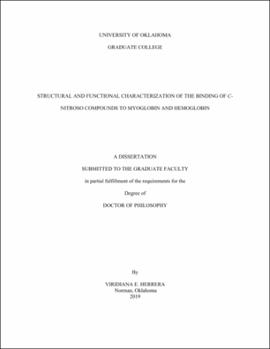| dc.description.abstract | The formation and structural characterization of the interactions of the oxygen-carrier proteins myoglobin (Mb) and hemoglobin (Hb) with C-nitroso metabolites are described. The spectroscopic studies and X-ray crystal structures provide a direct correlation and explanation of the toxic side-effects associated with bioactivation of nitrogenous species into C-nitroso (RNO) metabolites in vivo.
Chapter 1 introduces the physiological pathways that give rise to C-nitroso compounds and provides specific examples of prescription drugs and other small molecules known to undergo such biotransformations. This chapter also provides a brief overview of the health-related problems linked to the binding of RNOs to hemeproteins, such as methemoglobinemia, hemolytic anemia, and liver enzyme damage. Overviews of the structures of Mb and Hb, and the active-site amino acid movements expected to mediate heme-ligand binding are also provided.
Chapter 2 describes the selection process and biological significance of a series of nitroalkanes (RNO2; R = Me, Et, Pr, iPr) used as RNO precursors for this systematic study. The same ligands were then used to form the Mb-RNO adducts (under reducing conditions) in order to determine the influence of RNO sterics on ligand binding to Mb and the stability of the complexes resulting from such binding. In that same chapter, I also determined the influence of the distal-pocket amino acid residue His64 on ligand access into the active site, as well as resultant Mb-RNO complex stability. The apparent rates of formation of each ferrous MbII-RNO adduct and seven distinct X-ray crystal structures are presented here. The resulting X-ray crystal structures show that these RNOs favor the N-binding mode when forming the ferrous MbII-RNO complexes in both wt and the H64A mutant. However, the geometric orientations of the ligands differ significantly between protein models. In some cases, these spatial discrepancies are due to ligand sterics, and in others are due to the influence of distal pocket composition. These results reiterate the idea that protein-ligand interactions vary at the molecular level despite protein-ligand system similarities. Ultimately, these results depict how C-nitroso metabolites inhibit Mb from carrying out its role in O2 storage by occupying the active site.
In Chapter 3, I continued to monitor the interactions of C-nitroso compounds, but this time with hemoglobin as the target protein. Numerous studies indicate that RNO binding to Hb induces protein degradation. Yet, the molecular mechanism for this process remained largely unknown. Using the same techniques as described in Chapter 2, I prepared crystals of the RNO (R= Me, Et, Pr) bound Hb-ligand complexes and solved their X-ray crystal structures. As observed with Mb, these nitroso metabolites favored an N-bound state in both the α and β subunits, forming ferrous Hb[α-FeII(RNO)][β-FeII(RNO)] complexes. To determine the structural consequences of RNO binding, I continued to harvest and collect data (every ~2 weeks) on crystals from the same crystallization vial as those used to solve the ligand-bound structures. As a result, I obtained 4 additional distinct X-ray crystal structures that reveal key intermediate steps in the overall molecular mechanism of Hb degradation. From the MeNO set, one structure revealed ligand displacement by a water molecule, and congruent Fe oxidation into the ferric FeIII state. A different structure displayed hemichrome formation in the β subunit after EtNO binding. This was marked by bis-His coordination of the Fe center, which was accompanied by large unraveling of the βF-helix and βCys93 S-nitrosation. Another structure revealed that hemichrome formation is followed by simultaneous partial protein refolding and partial heme slippage. In this structure, Fe anomalous mapping revealed two positions for the metal: one in the original ligand-bound position and a second significantly displaced from the active site towards the solvent exterior of the protein (Fe-Fe measured distance of 5.2 Å). Finally, the PrNO related Hb structure was especially unique. In this structure, the β subunit of Hb was observed in two distinct degradation stages. The βF-helix was modeled in both the ligand bound folded state and the hemichrome unraveled form. Furthermore, Fe anomalous mapping indicated two positions for the heme with equal occupancies as the βHis92 residue that serves to anchor the metal in place. Together, these structures provide crystallographic evidence for i) ligand binding, ii) FeII oxidation, iii) hemichrome formation, and iv) the heme slippage intermediate steps leading to Hb degradation. Each structure details the global changes and active site chemistry that occurs at the time of RNO binding to Hb, and as the structure morphs as a result of C-nitroso binding.
Chapter 4 explores the importance of metal identity and redox state of the macrocycle on Mb-RNO complex formation. Here, CoMb and ChlMb were prepared by removing heme from native Mb and substituting it with Cobalt PPIX and Chlorin, respectively. The reactions of the ensuing proteins were monitored with the same series of alkyl nitroalkanes as described in Chapter 2 for comparison. My results indicate that RNO binding to reduced CoIIMb is unstable, evidenced by apparent oxidation of CoIIMb into CoIIIMb upon addition of RNO2 precursor. On the other hand, stable complex formation was observed with ChlMb. However, due to lack of X-ray crystallography results, the RNO binding mode (N vs O) remains unclear. Also discussed in this chapter are the interactions of native Mb with a series of nitrotoluenes (NTs) to probe the limits to which the active site of Mb can accommodate RNOs. Parallel studies were done with the H64A Mb mutant. In the wt species, binding of NT to ferrous MbII was unstable and resulted in spectral traits characteristic of the ferric wt MbIII-H2O species. Interestingly, the same reactions resulted in short-lived ferrous MbII-RNO complexes in the H64A analog. These results indicate that larger NTs can also bind Mb, but that the binding is transient. | en_US |
